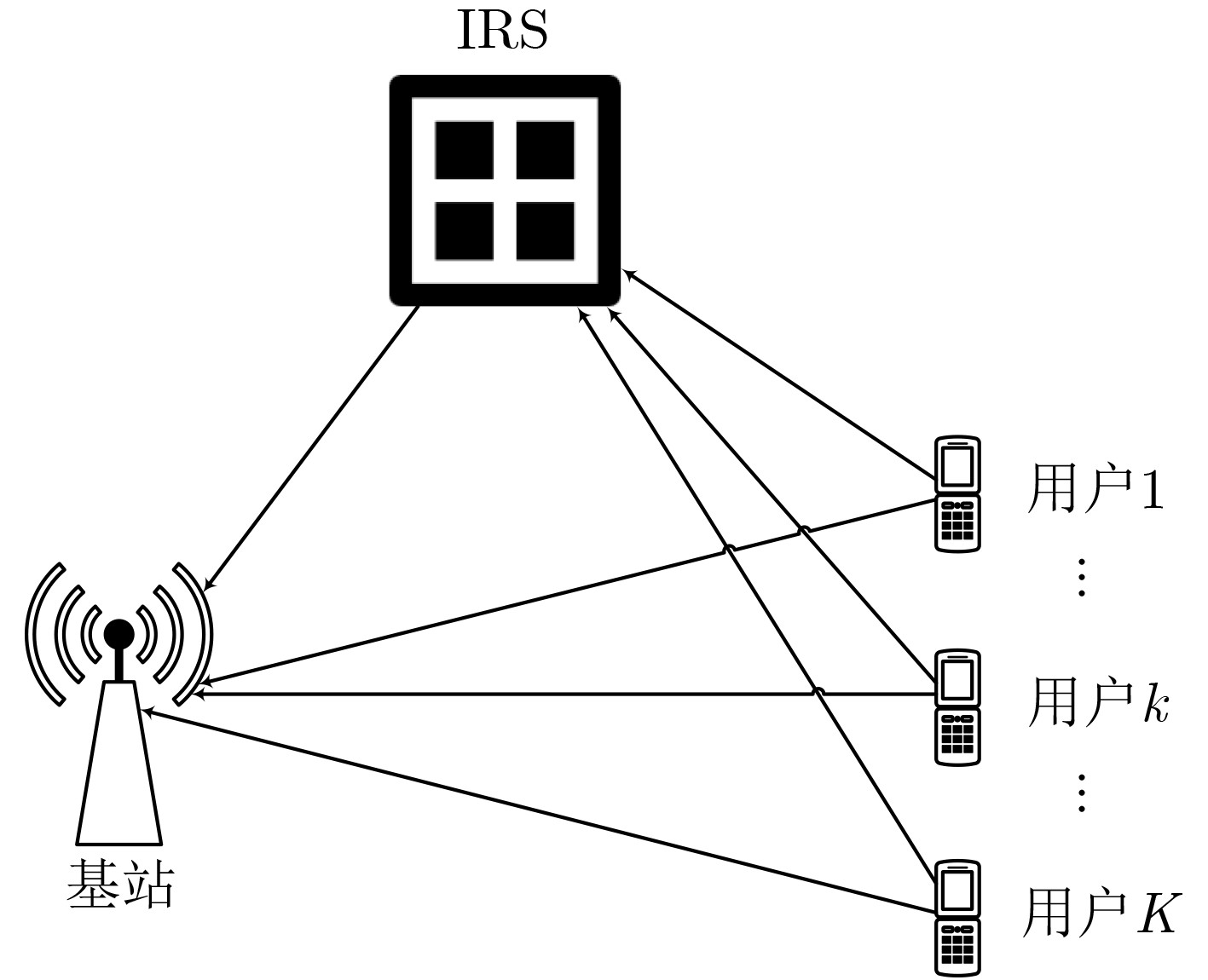IRS-aided Uplink NOMA Systems Resource Allocation Scheme Based on Power Minimization
-
摘要: 对于智能反射面(IRS)辅助的单簇上行非正交多址接入(NOMA)系统,该文提出一种最小化系统总功率的资源分配方案。首先构建最小化总功率的优化问题,优化参数为用户功率和IRS相移;然后,推导单个用户所需的功率与信道、用户的速率需求以及IRS相移之间的关系,将功率与相移的联合优化问题分解为多个包含单个参数的子优化问题;其次,采用迭代的方法求解所有的IRS相移,在每次迭代过程中,依次求解包含单个参数的子优化问题;最后,根据迭代得到的IRS相移计算出每个用户所需的最低功率。仿真结果显示,在速率需求相同的条件下,所提方案所需的总功率低于相同场景中的已有方案。Abstract: A resource allocation scheme to minimize the total power is proposed for IRS-Assisted single cluster uplink Non-Orthogonal Multiple Access (NOMA) systems. Firstly, the optimization problem is constructed to minimize the total power, and the parameters are power for each user and Intelligent Reflecting Surface (IRS) phase shifts. Secondly, the relationship among the power required by single user, the channel, the user's rate requirements and IRS phase shifts is deduced. The joint optimization problem of power and phase shifts is decomposed into several sub-optimization problems with a single parameter. Then, all IRS phase shifts are solved by an iterative method, and the sub-optimization problems with a single parameter are solved in turn during each iteration. Finally, the minimum power required by each user is calculated based on the IRS phase shifts obtained by iteration. Simulation results show that the total power of the proposed scheme is lower than that of existing schemes in the same scenario.
-
表 1 仿真参数
参数 数值 基站的覆盖半径R(m) 250 IRS反射单元数目N 1~32 噪声功率$ {\sigma ^2} $(dBm) –80 用户数目K 2-4 基站的信噪比$ {r_k} $(dB) 1~6 -
[1] 田辉, 倪万里, 王雯, 等. IRS辅助的边缘智能系统中基于数据重要性感知的资源分配[J]. 北京邮电大学学报, 2020, 43(6): 51–58. doi: 10.13190/j.jbupt.2020-162TIAN Hui, NI Wanli, WANG Wen, et al. Data-importance-aware resource allocation in IRS-aided edge intelligent system[J]. Journal of Beijing University of Posts and Telecommunications, 2020, 43(6): 51–58. doi: 10.13190/j.jbupt.2020-162 [2] DE SENA A S, CARRILLO D, FANG Fang, et al. What role do intelligent reflecting surfaces play in multi-antenna non-orthogonal multiple access[J]. IEEE Wireless Communications, 2020, 27(5): 24–31. doi: 10.1109/MWC.001.2000061 [3] LIU Yuanwei, LIU Xiao, MU Xidong, et al. Reconfigurable intelligent surfaces: Principles and opportunities[J]. IEEE Communications Surveys & Tutorials, 2021, 23(3): 1546–1577. doi: 10.1109/COMST.2021.3077737 [4] LI Xingwang, XIE Zhen, CHU Zheng, et al. Exploiting benefits of IRS in wireless powered NOMA networks[J]. IEEE Transactions on Green Communications and Networking, 2022, 6(1): 175–186. doi: 10.1109/TGCN.2022.3144744 [5] LIU Huiling, LI Geng, LI Xingwang, et al. Effective capacity analysis of STAR-RIS-assisted NOMA networks[J]. IEEE Wireless Communications Letters, 2022, 11(9): 1930–1934. doi: 10.1109/LWC.2022.3188443 [6] LI Geng, LIU Huiling, HUANG Gaojian, et al. Effective capacity analysis of reconfigurable intelligent surfaces aided NOMA network[J]. EURASIP Journal on Wireless Communications and Networking, 2021, 2021(1): 198. doi: 10.1186/s13638-021-02070-7 [7] ISLAM S M R, AVAZOV N, DOBRE O A, et al. Power-domain non-orthogonal multiple access (NOMA) in 5G systems: Potentials and challenges[J]. IEEE Communications Surveys & Tutorials, 2017, 19(2): 721–742. doi: 10.1109/COMST.2016.2621116 [8] MU Xidong, LIU Yuanwei, GUO Li, et al. Capacity and optimal resource allocation for IRS-assisted multi-user communication systems[J]. IEEE Transactions on Communications, 2021, 69(6): 3771–3786. doi: 10.1109/TCOMM.2021.3062651 [9] GUO Yiyu, QIAN Zhijin, LIU Yuanwei, et al. Intelligent reflecting surface aided multiple access over fading channels[J]. IEEE Transactions on Communications, 2021, 69(3): 2015–2027. doi: 10.1109/TCOMM.2020.3042277 [10] ZUO Jiakuo, LIU Yuanwei, QIN Zhijin, et al. Resource allocation in intelligent reflecting surface assisted NOMA systems[J]. IEEE Transactions on Communications, 2020, 68(11): 7170–7183. doi: 10.1109/TCOMM.2020.3016742 [11] MU Xidong, LIU Yuanwei, GUO Li, et al. Joint deployment and multiple access design for intelligent reflecting surface assisted networks[J]. IEEE Transactions on Wireless Communications, 2021, 20(10): 6648–6664. doi: 10.1109/TWC.2021.3075885 [12] ZHUANG Yuandong, LI Xi, JI Hong, et al. Exploiting intelligent reflecting surface for energy efficiency in ambient backscatter communication-enabled NOMA networks[J]. IEEE Transactions on Green Communications and Networking, 2022, 6(1): 163–174. doi: 10.1109/TGCN.2022.3144465 [13] WANG Hong, LIU Chen, SHI Zheng, et al. On power minimization for IRS-aided downlink NOMA systems[J]. IEEE Wireless Communications Letters, 2020, 9(11): 1808–1811. doi: 10.1109/LWC.2020.2999097 [14] ZUO Jiakuo, LIU Yuanwei, YANG Liang, et al. Reconfigurable intelligent surface enhanced NOMA assisted backscatter communication system[J]. IEEE Transactions on Vehicular Technology, 2021, 70(7): 7261–7266. doi: 10.1109/TVT.2021.3087582 [15] ZENG Ming, LI Xingwang, LI Gen, et al. Sum rate maximization for IRS-assisted uplink NOMA[J]. IEEE Communications Letters, 2021, 25(1): 234–238. doi: 10.1109/LCOMM.2020.3025978 [16] ZHANG Dingcai, WU Qingqing, CUI Miao, et al. Throughput maximization for IRS-assisted wireless powered hybrid NOMA and TDMA[J]. IEEE Wireless Communications Letters, 2021, 10(9): 1944–1948. doi: 10.1109/LWC.2021.3087495 [17] SONG D, SHIN W, and LEE J. A maximum throughput design for wireless powered communication networks with IRS-NOMA[J]. IEEE Wireless Communications Letters, 2021, 10(4): 849–853. doi: 10.1109/LWC.2020.3046722 [18] FANG Fang, XU Yanqing, PHAM Q V, et al. Energy-efficient design of IRS-NOMA networks[J]. IEEE Transactions on Vehicular Technology, 2020, 69(11): 14088–14092. doi: 10.1109/TVT.2020.3024005 [19] 马昊淳, 王鸿. 智能反射面辅助的上行NOMA系统低功耗传输方案研究[J]. 南京邮电大学学报:自然科学版, 2021, 41(5): 30–35. doi: 10.14132/j.cnki.1673-5439.2021.05.005MA Haochun and WANG Hong. On power minimization for IRS-aided uplink NOMA systems[J]. Journal of Nanjing University of Posts and Telecommunications:Natural Science, 2021, 41(5): 30–35. doi: 10.14132/j.cnki.1673-5439.2021.05.005 [20] MA Haochun and WANG Hong. Power minimization transmission design for IRS-assisted uplink NOMA systems[C]. 2021 IEEE 94th Vehicular Technology Conference (VTC2021-Fall), Norman, USA, 2021: 1–4. [21] WU Qingqing and ZHANG Rui. Intelligent reflecting surface enhanced wireless network via joint active and passive beamforming[J]. IEEE Transactions on Wireless Communications, 2019, 18(11): 5394–5409. doi: 10.1109/TWC.2019.2936025 [22] ZHENG Beixiong, WU Qingqing, and ZHANG Rui. Intelligent reflecting surface-assisted multiple access with user pairing: NOMA or OMA?[J]. IEEE Communications Letters, 2020, 24(4): 753–757. doi: 10.1109/LCOMM.2020.2969870 -






 下载:
下载:




 下载:
下载:
